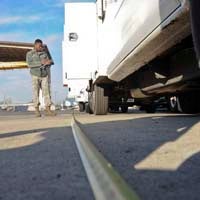Relief effort tests new system
Published 8:34 pm Monday, December 3, 2012
By Staff Sgt. David Carbajal
Special to the News-Herald

Senior Airman Marquis Cole, 305th Aerial Port Squadron aerial transportation specialist, uses a tape measure to process a utility and line truck, Nov. 16, 2012, during the cargo in-check at Joint Base McGuire-Dix-Lakehurst, N.J. Cole and his fellow aerial transportation specialists measured the vehicle's length, width and height, which will be used by load planners to facilitate cargo manifests. (Staff Sgt. David Carbajal/U.S. Air Force)
To assist with their hurricane-relief efforts, members of the 305th Aerial Port Squadron at Joint Base McGuire-Dix in Lakehurst, N.J., have been using a sophisticated electronic system that streamlines the unit’s cargo processing.
Aerial transportation specialists are employing the Deployable Automated Cargo Measurement System to prepare vehicles and equipment for airlift.
“It creates a standard throughput operation that allows us to process cargo quickly,” said Capt. Andrew Gordon, a Smithfield native and the 305th APS’ operations officer. “This system allows APS to utilize nearly any solid flat surface to process cargo.”
The system consists of two laser-enabled reading posts and a set of digital floor-pad sensors, which takes digital measurements required for the unit’s automated load-planning systems.
The unit acquired DACMS in 2011 as APS planners forecasted several construction projects, which would likely affect the unit’s ability to conduct inspections in fixed facilities.
“The benefit to DACMS is it’s a very versatile, portable system,” said Gordon. “We can set it up practically anywhere.
The process is fairly simple once DACMS is set up.
“You just drive through it,” said Senior Airman Marquis Cole, 305th APS aerial transportation specialist and an Independence, La., native. “The system makes a digital blueprint of the vehicle and then provides us with the key information.”
DACMS can measure and record a vehicle’s length, width, height, weight, number of axles and center of balance in less than 20 seconds, and without the vehicle operator having to come to a halt.
“Once a vehicle is processed, the load planners take the data and, essentially, create digital puzzle pieces, which they then use to create load plans for upcoming airlift missions,” said Gordon. “All of the data DACMS calculates is significant. It allows us to quickly determine how to load the vehicles and keep the weight balanced on the aircraft.”
APS recently found this system effective in the base’s recent Hurricane Sandy response.
“We used DACMS extensively during the hurricane-relief redeployment,” said Gordon, a graduate of Clemson University, S.C. “The outbound units requiring airlift preparation would have quickly log-jammed without the system. In short, processing time was significantly reduced through the use of this system.”
Additionally, DACMS’s portability allowed APS personnel to separate standard operations from hurricane-response operations by processing the cargo in different areas. Unit personnel fulfilled two missions simultaneously while maintaining efficiency and expediency.
“Our normal operations did not stop because of the hurricane,” said Gordon. “By separating normal ‘ops’ from hurricane ‘ops,’ each maintained its solidarity and quality.”





